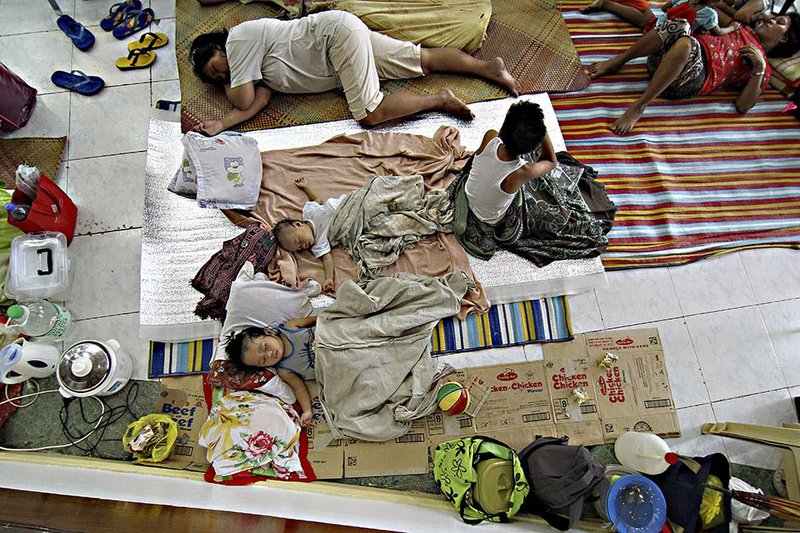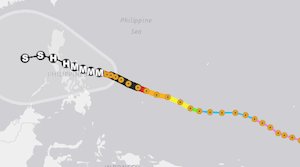MANILA, Philippines -- A ferocious and erratic typhoon blew closer to the Philippines on Friday, as differing forecasts about its path -- one predicting it will graze the capital Manila -- prompted a wide swath of the country to prepare for a weekend of destructive winds and rain.
Typhoon Hagupit -- Filipino for "smash" -- was expected to hit the central Philippines late today, lashing parts of a region that was devastated by last year's Typhoon Haiyan, which left more than 7,300 people dead and missing.
The typhoon regained strength early today but forecasters said it would rapidly weaken as it approached land.
"I'm scared," said Haiyan survivor Jojo Moro. "I'm praying to God not to let another disaster strike us again. We haven't recovered from the first."
The 42-year-old businessman, who lost his wife, daughter and mother last year in Tacloban city, said he stocked up on sardines, instant noodles, eggs and water.
Dozens of domestic flights were canceled and inter-island ferry services were suspended as the storm approached.
In Tacloban, where Haiyan's tsunami-like storm surges left thousands dead and wiped out entire villages, and in outlying provinces, about half a million people have been moved from high-risk villages to emergency shelters and safer grounds, Welfare Secretary Dinky Soliman said.
"We've not heard of villagers resisting to be evacuated," regional disaster-response director Blanche Gobenciong said. "Their trauma is still so fresh."
Haiyan caught people unprepared to deal with its ferocity. Most stores and supermarkets in Tacloban were looted by residents in the aftermath of the storm, when food, water and other supplies were damaged or destroyed.
At least 47 of the country's 81 provinces are considered potentially at high risk from Hagupit, officials said. The first one in its path is Eastern Samar province, where it is expected to make landfall. It is then expected to cut across central islands along a route north. But its path thereafter is debatable.
The computer models of the two agencies tracking the typhoon closely -- the U.S. military's Joint Typhoon Warning Center in Hawaii and the Philippine weather agency -- predicted different paths for the typhoon.
The U.S. agency said Hagupit may veer north after going inland and sweep past the southern edge of Manila, a city of more than 12 million people. The Philippine agency projected a more southern path.
The typhoon, which had weakened some Friday, strengthened again early today, but both agencies said it would weaken again as it hit land.
The Philippine weather agency said it was packing winds of 121 miles per hour and gusts of 143 mph early today. The U.S. center, using one-minute average wind speed with higher readings than the Philippine agency's 10-minute average, said Hagupit was again a super typhoon with maximum sustained winds of 149 mph and gusts of 184 mph.
Gobenciong said the unpredictable path of the typhoon made it harder to ascertain which areas would be hit.
"We have a zero-casualty target," she said. "Just one loss of life will really sadden us all and make us wonder what went wrong."
Hagupit's erratic behavior prompted the government to call an emergency meeting of officials in the metropolitan Manila area. Defense Secretary Voltaire Gazmin said he'd rather "over-prepare than under-prepare."
Manila Mayor Joseph Estrada said that authorities have alerted residents.
"We are ready," he said, but pointed out that "these typhoons change direction all the time."
Haiyan demolished about 1 million houses and displaced some 4 million people in the central Philippines. Hundreds of residents still living in tents in Tacloban have been prioritized in the ongoing evacuation.
Dr. Steven Godby, an expert in natural hazards at Nottingham Trent University in Nottingham, England, said the Philippines experiences five to 10 cyclones a year on average, more than any other country.
He said the right oceanic conditions to create deadly typhoons "come together in the western Pacific and put the Philippines in the firing line as a result.
Information for this article was contributed by Teresa Cerojano of The Associated Press.
A Section on 12/06/2014

